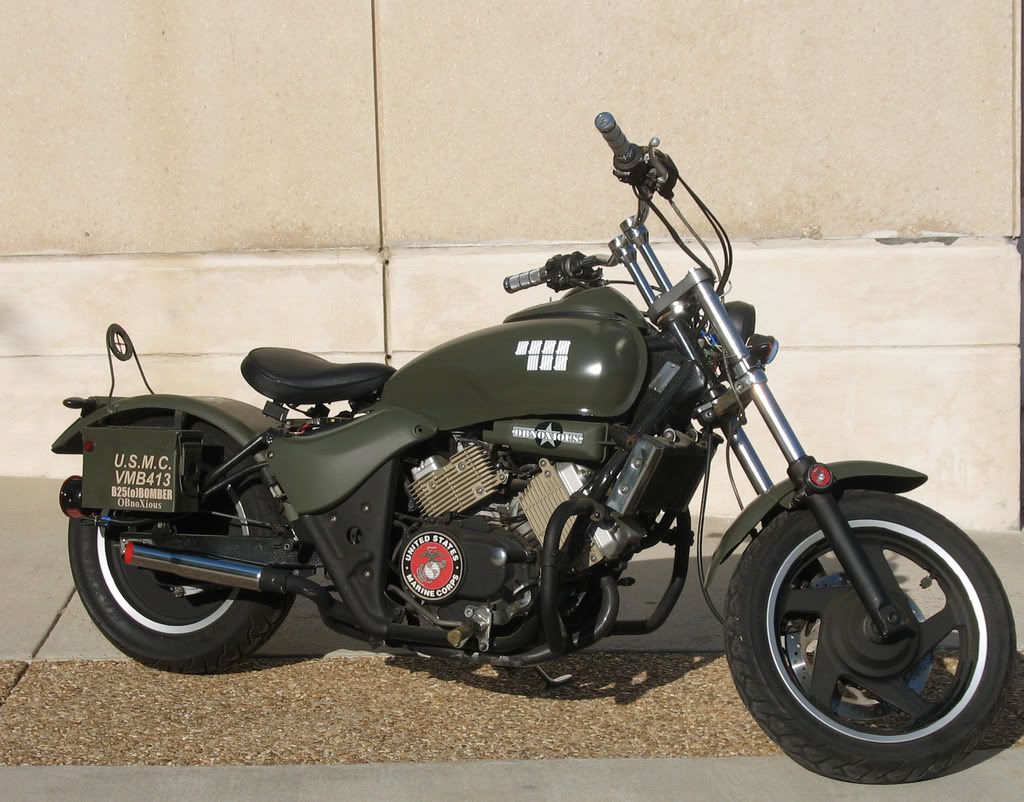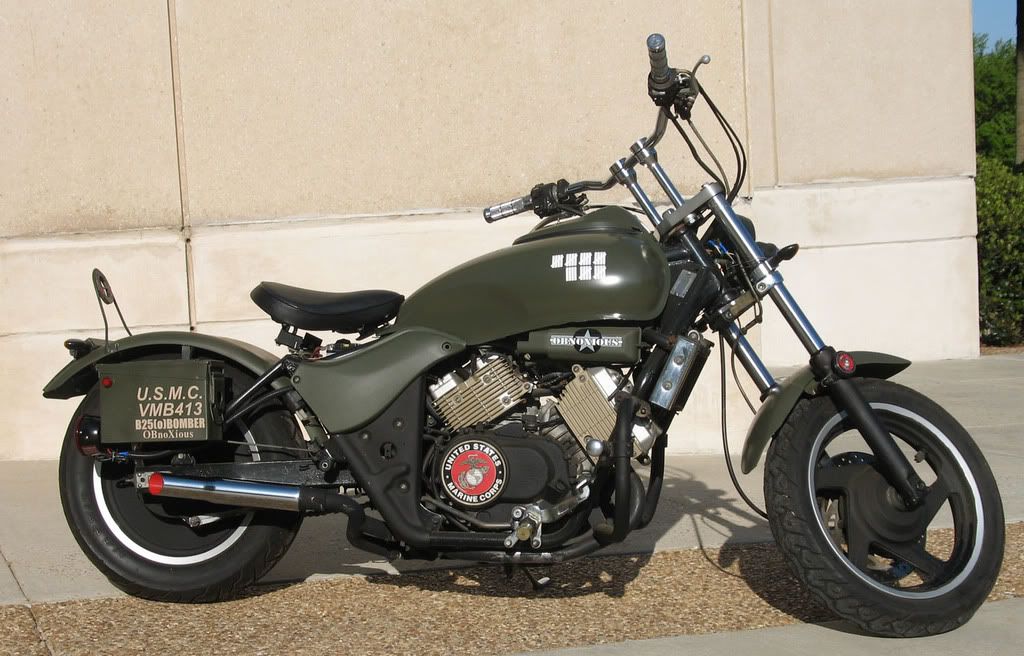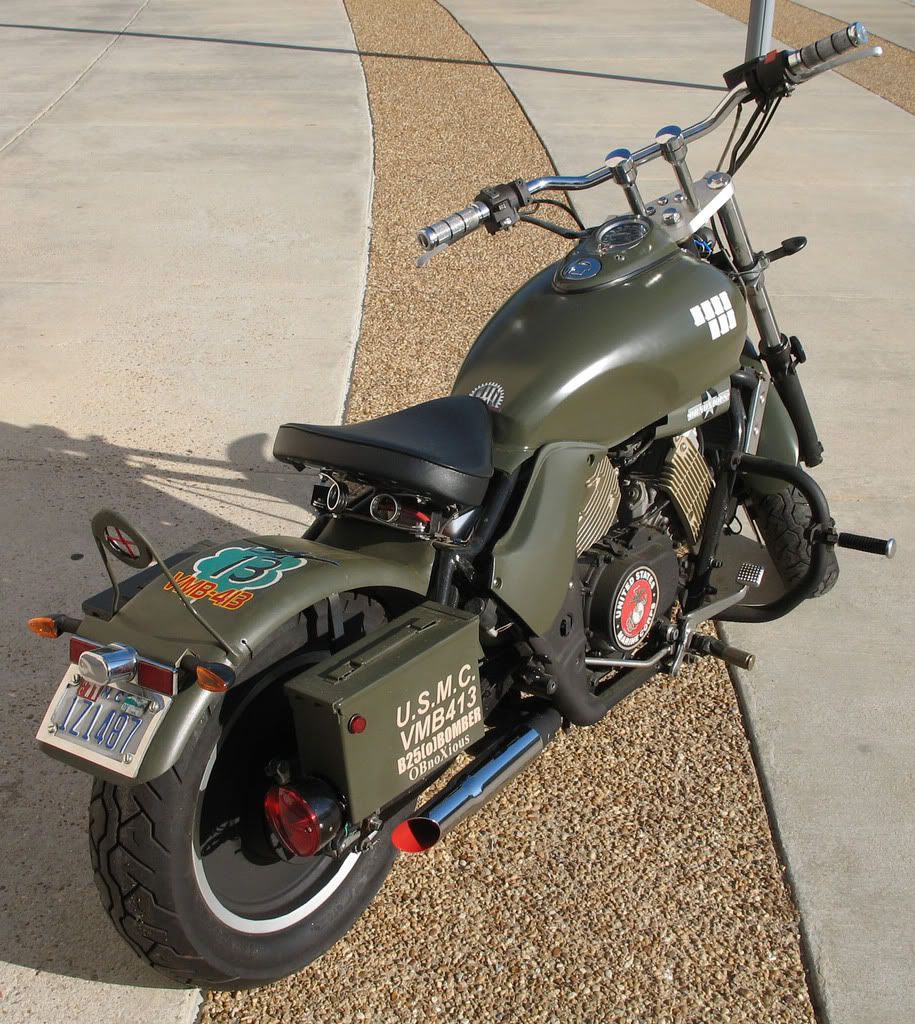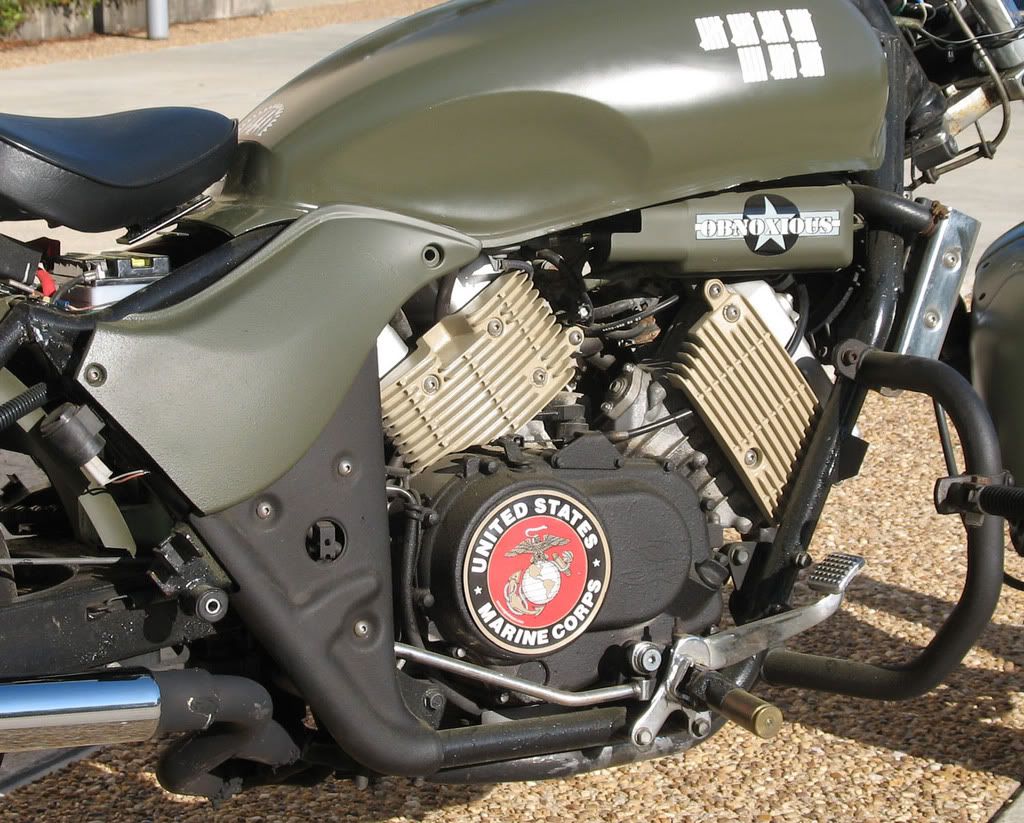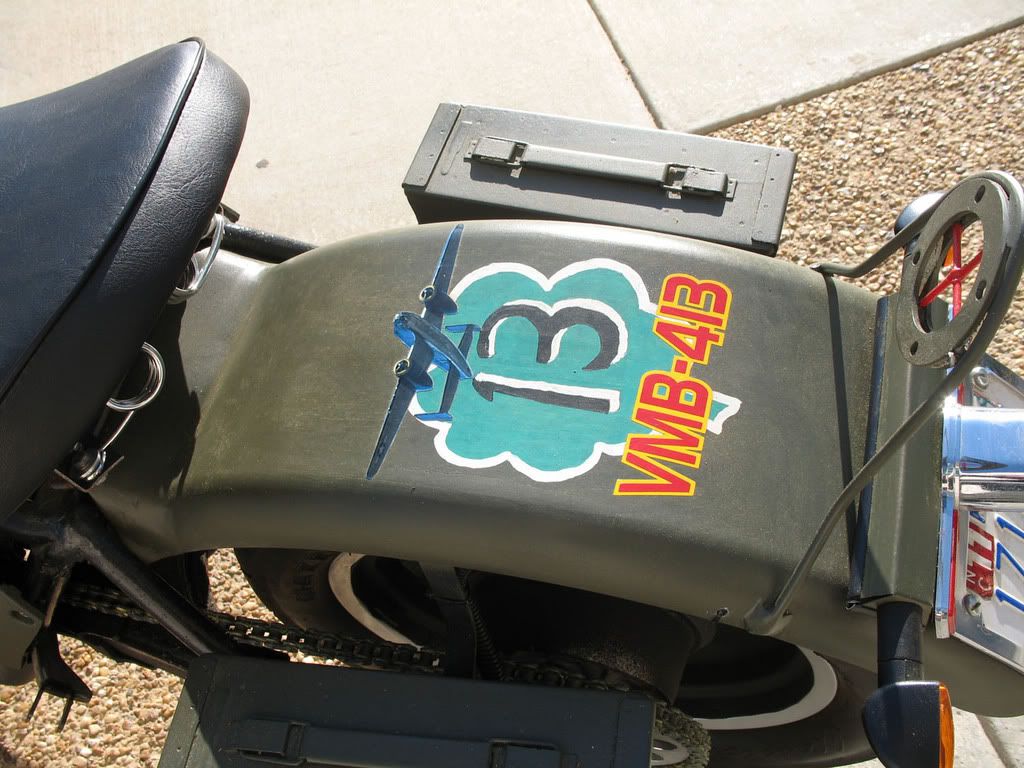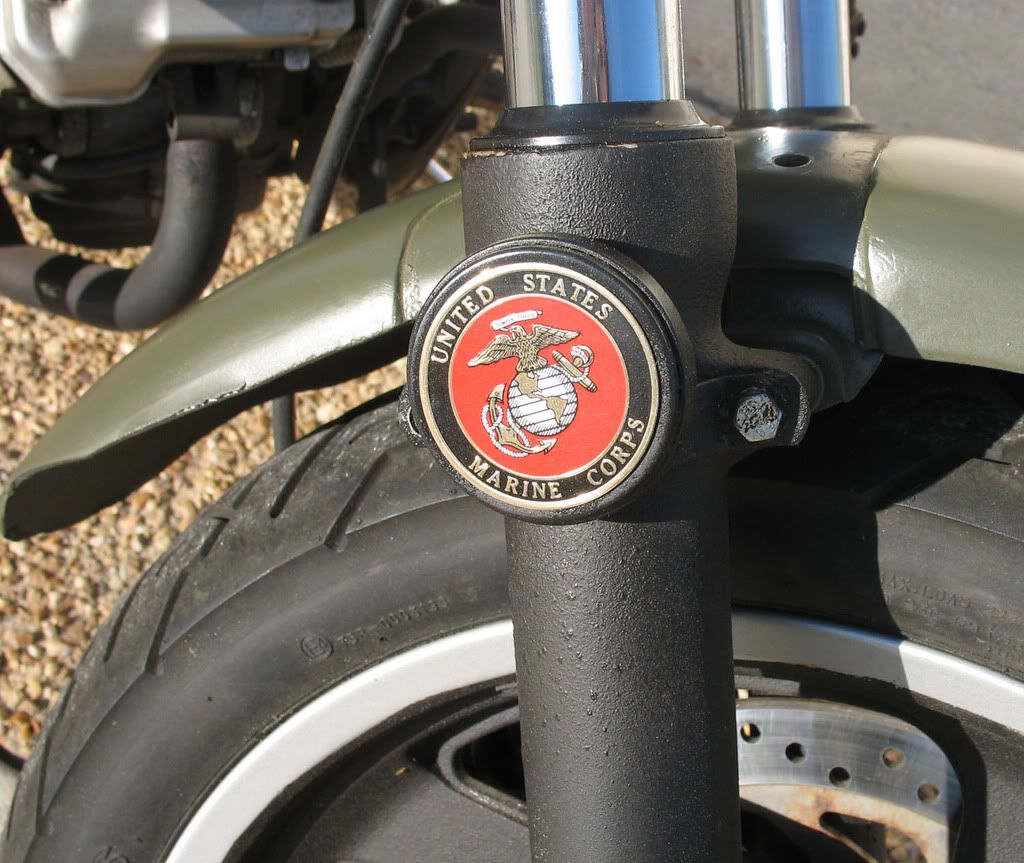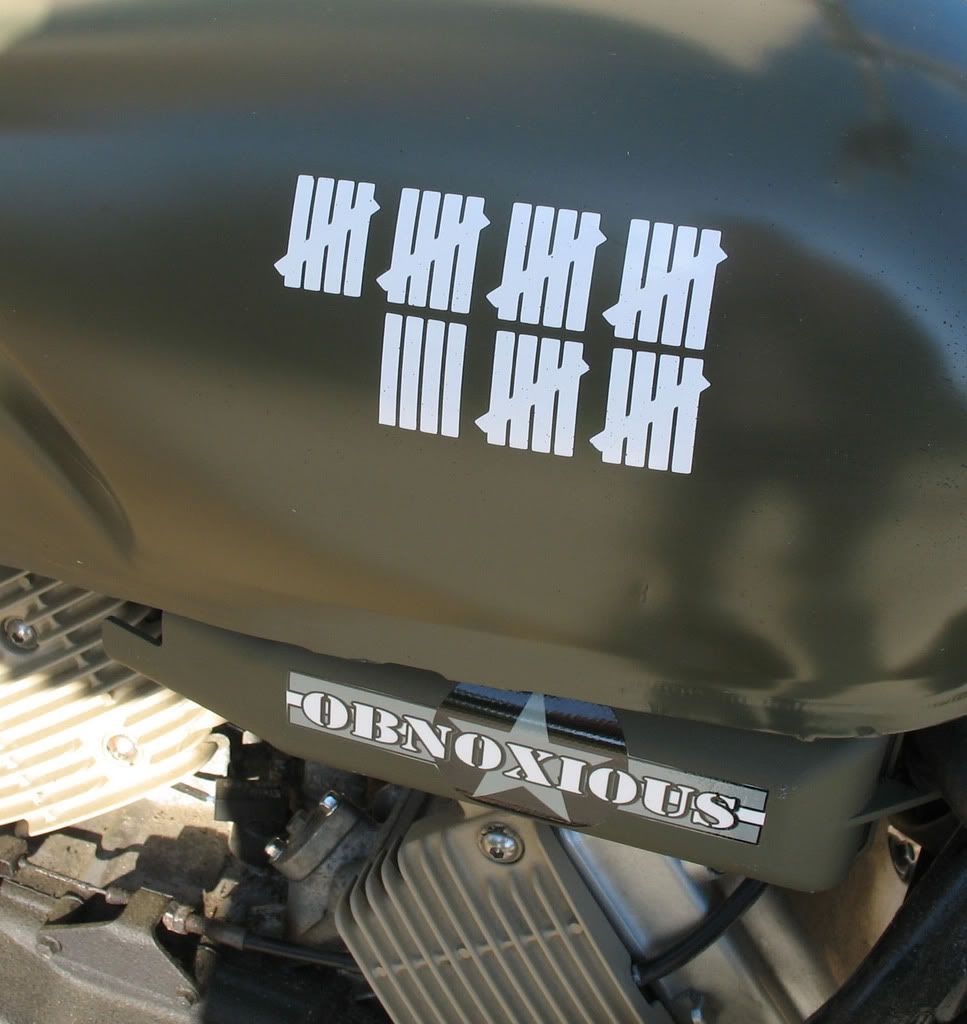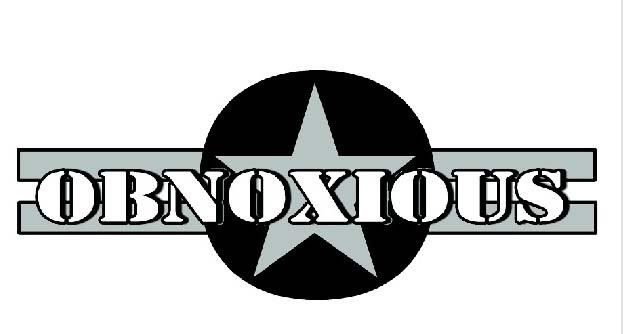A TRIBUTE TO MY DAD (transforming a Kymco Venox)
Posted: Thu Apr 12, 2007 6:58 pm
A TRIBUTE TO MY DAD
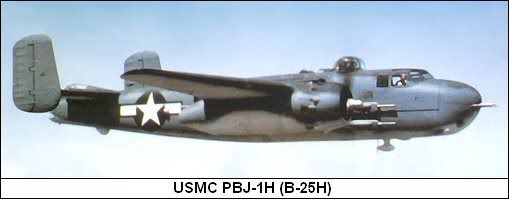
Well.....my dad was a marine corp pilot in WWII in the solomon islands.
He was a Major and flew in one of the first squadrons there.
(VMB-413)
He flew many different planes but most flight time and missions were flown in the B25 "PBJ" U.S.M.C. TWIN ENGINE BOMBER also known as the "MITCHELL BOMER" a variation which was used in the famous DOOLITTLE RAID on Tokyo where they took off aircraft carriers at the begining of the war.
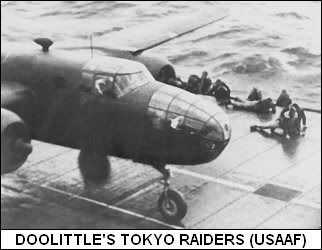
here's some...
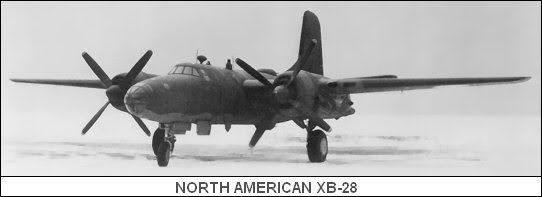
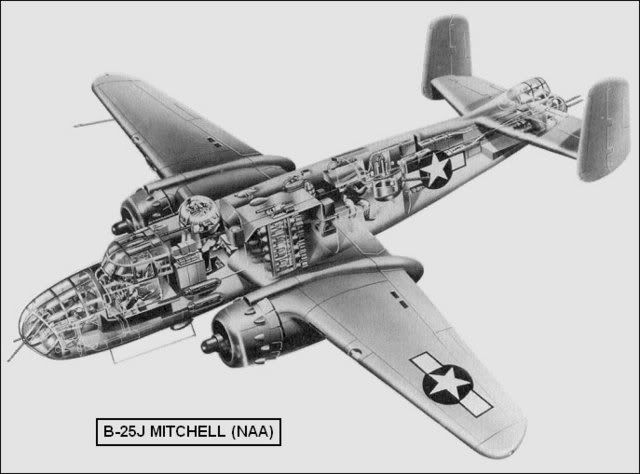
A SHORT HISTORY
In February 1943, the first B-25C and D models were delivered to the Navy and given the designation PBJ-1C and PBJ-1D respectively. Army model letters was used to designate all subsequent PBJ variants. The Navy's Mitchells were to be used in the reconnaissance, anti-shipping and close support roles and flown by Marine Corps crews.
The first Marine bombing squadron, VMB-413, was organized in March 1943, and a number of its PBJ-1s were fitted with search radars mounted in place of the lower turret.
Since most Marine Corps pilots and crews were operating single-engine fighter and attack aircraft, VMB-413 acted as a training squadron for air and ground crews in the twin-engine Mitchell. By October 1943, seven more squadrons, VMB-423, 433, 443, 611, 612, 613 and 614, had been equipped with PBJ-1s to form the first Marine Medium Bombardment Group. First to see action in the Pacific was VMB-413, which arrived in January 1944 and entered combat in March of that year.
The squadron flew its first combat missions from Sterling Island, flying both day and night bombing strikes against targets in the Rabaul and Bougainville areas. Having to develop new tactics, the Marine PBJs suffered heavy losses at first. However, the squadron's effectiveness was noted in a commendation from the Army commander of aircraft in the Solomons area (ComAirSols), Brig. General William A. Matheny:
… you have, in the space of a few weeks, matched similar units which have been operating under ComAirSols for nine months… You have, further, developed the dangerous, tiresome mission of night heckling against the enemy bases to the highest perfection it has attained in the fourteen months I have been working under ComAirSols.
In late 1943, newer PBJ-1Hs were delivered, fitted with a 75mm cannon mounted in the nose and additional forward-firing .50 caliber guns. These were followed by PBJ-1Js in the spring of 1944. Those H models fitted with radar had a radome in the nose, while the PBJ-1J's radar was mounted on the right wingtip, allowing either a clear bombardier nose or solid gun nose to be fitted. In addition, both models could carry eight air-to-ground High-Velocity Aircraft Rockets (HVAR) mounted under the wings. As described below, the rockets proved more effective than the slow-firing 75mm gun, which rarely got off more than 3 or 4 rounds during a pass on a target.
VMB-612, commanded by Lt. Col. Jack Cram, was selected for special training in night attacks on enemy shipping, using radar to locate and attack the targets. In addition to conventional bombs and torpedoes, the new 5-inch HVAR rockets were tried and found to be highly accurate and effective. By flying level about 300 feet above the water and correcting for wind and temperature variations, Cram's pilots learned to judge the rockets range. In one practice attack on a small island only 200 feet long by 100 feet wide, the squadron fired over 250 HVARs and scored 56 percent hits.
In November 1944, VMB-612 was stationed on Saipan, but the nearest shipping targets were near Iwo Jima and Chichi, 630 and 750 miles to the north, respectively. Cram's squadron stripped their PBJs of excess weight, including the upper turrets and cheek guns, and carrying 1520 gallons of fuel, successfully flew missions which lasted 10-12 hours.
From Saipan, VMB-612 moved to Iwo Jima in April 1945, where it could reach the coast of Japan during its nigh-time anti-shipping strikes. Cram's squadron claimed 7 ships sunk and 80 damaged during missions from Saipan and Iwo, with a loss of three PBJs in combat. On July 28, 1945, VMB-612 departed for its next base on Okinawa.
The HVAR rockets shown to be so effective by VMB-612 were an early product of the Naval Ordnance Test Station (NOTS) established at China Lake in 1943. Working with civilian scientists from the California Institute of Technology, the NOTS developed aircraft rocket weapons, including the big 11.75-inch "Tiny Tim", intended for attacks on enemy bunkers and other protected targets. Being the "rocket experts", VMB-612's PBJ-1Js were fitted with mounts for two Tiny Tims, one on each side of the fuselage, above the bomb bay doors. Cram's pilots flew three night missions with the big rockets against targets in southern Japan on August 11, 12 and 13, 1945, in the last days of the war.
Just over 700 PBJs were delivered to the Marines, 50 PBJ-1Cs, 152 Ds, 1 or 2 Gs, 248 Hs and 255 PBJ-1Js. Performance of the PBJ-1J powered by two Wright R-2600-29 1,700 horsepower engines included a top speed of around 275 mph at 12,500 feet, a cruse of 230 mph and normal range of 1,560 statute miles. Service ceiling was 20,600 feet with a normal gross weight of 34,000 pounds. A typical PBJ-1J was armed with twelve 0.50 caliber machine guns and up to 4,000 pounds of bombs, a Mark 13 aerial torpedo or 8 HVAR rockets.
Marine bomber squadrons lost 45 PBJs to all causes, along with 173 officers and men. Given the unusual reasons for choosing the Army-designed North American bomber, it is hard to imagine an aircraft more effective than the PBJ in the hands of its U.S. Marine Corps pilots and crews.
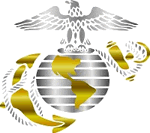

more info:
VMB-413, nicknamed, The Flying Nightmares, was the first squadron to see combat beginning in March 1944. VMB-413 began operations from Stirling Island in the Treasury Group. The primary job was heckling Japanese installations at Kavieng on New Ireland and Rabaul on New Britain.
The squadron's primary mission was heckling Japanese installations at Kavieng on New Ireland and Rabaul on New Britain. Losses were exceptionally heavy during the first two months of operation with VMB-413 losing five aircraft and 27 men, mostly through enemy action.
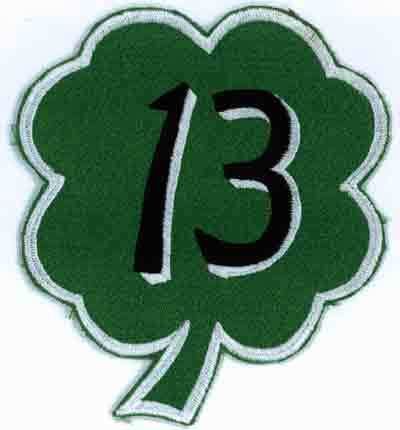
VMB-413 Patch
[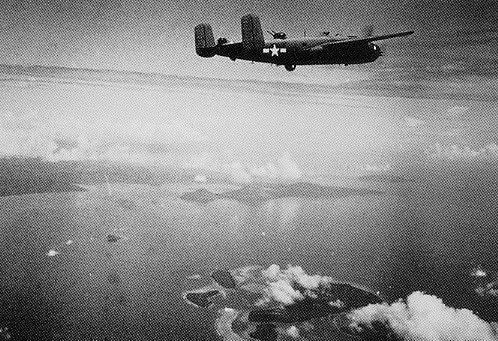
PBJ approaching Prince of York Island March 1944
[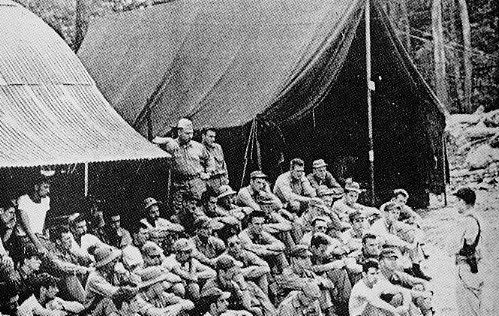
The Boys
My Dad...back row left (not the sgt. in the inset)


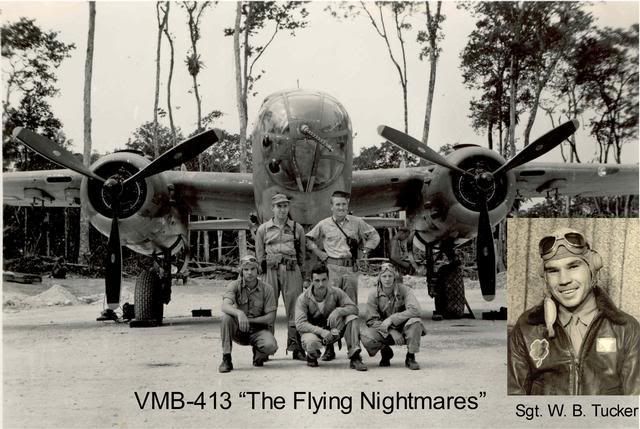


VMB-413 was the first Marine PBJ squadron formed.
Commissioned at Marine Corps Air Station (MCAS) Cherry Point, North Carolina on 1 March 1943 the squadron moved to Naval Air Station (NAS) North Island, San Diego, California in December 1943 after completing training.
Departing the U.S. on 3 January 1944 with their PBJs tied down on the deck of the escort aircraft carrier USS Kalinin Bay (CVE-68) for transport to MCAS Ewa, Territory of Hawaii. The air echelon then flew their aircraft to Naval Operating Base (NOB) Espiritu Santo on Espiritu Santo Island, New Hebrides Islands (15.15S, 166.51E) arriving on 27 January 1944 with 13 PBJ-1Ds.
After receiving familiarization training, VMB-413 moved forward to Stirling Island, Treasury Islands, British Solomon Islands (7.13S, 155.19E), on 7 March. Located about 30 miles (48 km) off the southwest coast of Bougainville Island, this base made it easy to fly bombing and heckling missions against targets on Bougainville and the huge Japanese base at Rabaul on New Britain Island.
The squadron flew its first mission against a supply dump near Rabaul on 14 March and for the next week, joined USAAF and USN aircraft in attacking the Rabaul area.
After these preliminary raids, VMB-413 switched to its primary function, night heckling raids against Japanese installations on Bougainville and Rabaul.
The squadron returned to NOB Espiritu Santo in May 1944 for rest and recreation and then moved forward to Munda Airfield (8.00S, 157.15E) on New Georgia Island in the British Solomon Islands and commenced bombing and strafing heckling operations against the Kahili-Choiseul area of Bougainville Island.
On 18 October 1944, the squadron moved to Marine Corps Air Facility (MCAF) Emirau on Emirau Island (1.40S, 150.00E) in the St. Matthias Group of the Bismarck Archipelago. For the remainder of the war, the squadron flew missions against the bypassed Japanese forces on New Britain and New Ireland Islands.
On 17 August 1945, the squadron was ordered to transfer to Titcomb Field, Malabang, Mindanao, Philippines Islands.
PS, interesting side note my son spent his 4 years in the Corps also at Cherry Point in aviation supply. (2001-2005)
~~~~~~~~~~~~~~~~~~~~~~~~~~~~~~~~~~~~~~~~~~~~~~~
A Newspaper interview Dec. 3rd 1996
D.F.C. Society

PS, this interview was more then I had ever heard from him about WWII in all the years before and after... typical of WWII vets.

Well.....my dad was a marine corp pilot in WWII in the solomon islands.
He was a Major and flew in one of the first squadrons there.
(VMB-413)
He flew many different planes but most flight time and missions were flown in the B25 "PBJ" U.S.M.C. TWIN ENGINE BOMBER also known as the "MITCHELL BOMER" a variation which was used in the famous DOOLITTLE RAID on Tokyo where they took off aircraft carriers at the begining of the war.

here's some...


A SHORT HISTORY
In February 1943, the first B-25C and D models were delivered to the Navy and given the designation PBJ-1C and PBJ-1D respectively. Army model letters was used to designate all subsequent PBJ variants. The Navy's Mitchells were to be used in the reconnaissance, anti-shipping and close support roles and flown by Marine Corps crews.
The first Marine bombing squadron, VMB-413, was organized in March 1943, and a number of its PBJ-1s were fitted with search radars mounted in place of the lower turret.
Since most Marine Corps pilots and crews were operating single-engine fighter and attack aircraft, VMB-413 acted as a training squadron for air and ground crews in the twin-engine Mitchell. By October 1943, seven more squadrons, VMB-423, 433, 443, 611, 612, 613 and 614, had been equipped with PBJ-1s to form the first Marine Medium Bombardment Group. First to see action in the Pacific was VMB-413, which arrived in January 1944 and entered combat in March of that year.
The squadron flew its first combat missions from Sterling Island, flying both day and night bombing strikes against targets in the Rabaul and Bougainville areas. Having to develop new tactics, the Marine PBJs suffered heavy losses at first. However, the squadron's effectiveness was noted in a commendation from the Army commander of aircraft in the Solomons area (ComAirSols), Brig. General William A. Matheny:
… you have, in the space of a few weeks, matched similar units which have been operating under ComAirSols for nine months… You have, further, developed the dangerous, tiresome mission of night heckling against the enemy bases to the highest perfection it has attained in the fourteen months I have been working under ComAirSols.
In late 1943, newer PBJ-1Hs were delivered, fitted with a 75mm cannon mounted in the nose and additional forward-firing .50 caliber guns. These were followed by PBJ-1Js in the spring of 1944. Those H models fitted with radar had a radome in the nose, while the PBJ-1J's radar was mounted on the right wingtip, allowing either a clear bombardier nose or solid gun nose to be fitted. In addition, both models could carry eight air-to-ground High-Velocity Aircraft Rockets (HVAR) mounted under the wings. As described below, the rockets proved more effective than the slow-firing 75mm gun, which rarely got off more than 3 or 4 rounds during a pass on a target.
VMB-612, commanded by Lt. Col. Jack Cram, was selected for special training in night attacks on enemy shipping, using radar to locate and attack the targets. In addition to conventional bombs and torpedoes, the new 5-inch HVAR rockets were tried and found to be highly accurate and effective. By flying level about 300 feet above the water and correcting for wind and temperature variations, Cram's pilots learned to judge the rockets range. In one practice attack on a small island only 200 feet long by 100 feet wide, the squadron fired over 250 HVARs and scored 56 percent hits.
In November 1944, VMB-612 was stationed on Saipan, but the nearest shipping targets were near Iwo Jima and Chichi, 630 and 750 miles to the north, respectively. Cram's squadron stripped their PBJs of excess weight, including the upper turrets and cheek guns, and carrying 1520 gallons of fuel, successfully flew missions which lasted 10-12 hours.
From Saipan, VMB-612 moved to Iwo Jima in April 1945, where it could reach the coast of Japan during its nigh-time anti-shipping strikes. Cram's squadron claimed 7 ships sunk and 80 damaged during missions from Saipan and Iwo, with a loss of three PBJs in combat. On July 28, 1945, VMB-612 departed for its next base on Okinawa.
The HVAR rockets shown to be so effective by VMB-612 were an early product of the Naval Ordnance Test Station (NOTS) established at China Lake in 1943. Working with civilian scientists from the California Institute of Technology, the NOTS developed aircraft rocket weapons, including the big 11.75-inch "Tiny Tim", intended for attacks on enemy bunkers and other protected targets. Being the "rocket experts", VMB-612's PBJ-1Js were fitted with mounts for two Tiny Tims, one on each side of the fuselage, above the bomb bay doors. Cram's pilots flew three night missions with the big rockets against targets in southern Japan on August 11, 12 and 13, 1945, in the last days of the war.
Just over 700 PBJs were delivered to the Marines, 50 PBJ-1Cs, 152 Ds, 1 or 2 Gs, 248 Hs and 255 PBJ-1Js. Performance of the PBJ-1J powered by two Wright R-2600-29 1,700 horsepower engines included a top speed of around 275 mph at 12,500 feet, a cruse of 230 mph and normal range of 1,560 statute miles. Service ceiling was 20,600 feet with a normal gross weight of 34,000 pounds. A typical PBJ-1J was armed with twelve 0.50 caliber machine guns and up to 4,000 pounds of bombs, a Mark 13 aerial torpedo or 8 HVAR rockets.
Marine bomber squadrons lost 45 PBJs to all causes, along with 173 officers and men. Given the unusual reasons for choosing the Army-designed North American bomber, it is hard to imagine an aircraft more effective than the PBJ in the hands of its U.S. Marine Corps pilots and crews.


more info:
VMB-413, nicknamed, The Flying Nightmares, was the first squadron to see combat beginning in March 1944. VMB-413 began operations from Stirling Island in the Treasury Group. The primary job was heckling Japanese installations at Kavieng on New Ireland and Rabaul on New Britain.
The squadron's primary mission was heckling Japanese installations at Kavieng on New Ireland and Rabaul on New Britain. Losses were exceptionally heavy during the first two months of operation with VMB-413 losing five aircraft and 27 men, mostly through enemy action.

VMB-413 Patch
[

PBJ approaching Prince of York Island March 1944
[

The Boys
My Dad...back row left (not the sgt. in the inset)





VMB-413 was the first Marine PBJ squadron formed.
Commissioned at Marine Corps Air Station (MCAS) Cherry Point, North Carolina on 1 March 1943 the squadron moved to Naval Air Station (NAS) North Island, San Diego, California in December 1943 after completing training.
Departing the U.S. on 3 January 1944 with their PBJs tied down on the deck of the escort aircraft carrier USS Kalinin Bay (CVE-68) for transport to MCAS Ewa, Territory of Hawaii. The air echelon then flew their aircraft to Naval Operating Base (NOB) Espiritu Santo on Espiritu Santo Island, New Hebrides Islands (15.15S, 166.51E) arriving on 27 January 1944 with 13 PBJ-1Ds.
After receiving familiarization training, VMB-413 moved forward to Stirling Island, Treasury Islands, British Solomon Islands (7.13S, 155.19E), on 7 March. Located about 30 miles (48 km) off the southwest coast of Bougainville Island, this base made it easy to fly bombing and heckling missions against targets on Bougainville and the huge Japanese base at Rabaul on New Britain Island.
The squadron flew its first mission against a supply dump near Rabaul on 14 March and for the next week, joined USAAF and USN aircraft in attacking the Rabaul area.
After these preliminary raids, VMB-413 switched to its primary function, night heckling raids against Japanese installations on Bougainville and Rabaul.
The squadron returned to NOB Espiritu Santo in May 1944 for rest and recreation and then moved forward to Munda Airfield (8.00S, 157.15E) on New Georgia Island in the British Solomon Islands and commenced bombing and strafing heckling operations against the Kahili-Choiseul area of Bougainville Island.
On 18 October 1944, the squadron moved to Marine Corps Air Facility (MCAF) Emirau on Emirau Island (1.40S, 150.00E) in the St. Matthias Group of the Bismarck Archipelago. For the remainder of the war, the squadron flew missions against the bypassed Japanese forces on New Britain and New Ireland Islands.
On 17 August 1945, the squadron was ordered to transfer to Titcomb Field, Malabang, Mindanao, Philippines Islands.
PS, interesting side note my son spent his 4 years in the Corps also at Cherry Point in aviation supply. (2001-2005)
~~~~~~~~~~~~~~~~~~~~~~~~~~~~~~~~~~~~~~~~~~~~~~~
A Newspaper interview Dec. 3rd 1996
More on the D.F.C. click here:York County man honored for role in World War II victory in Pacific
Awarded: Distinguished Flying Cross
Thanksgiving....somewhere in the Pacific
On Thanksgiving Day ,1944 Marine 1st. Lt. George Barlow was nearing the end of his combat tour in the South Pacific.For the previous nine months , Barlow had flown combat missions from a small island in the chain known as the Solomons.His squadron, VMB 413 was part of the air campain which prepared the way for the Marine landing forces which were island -hopping their way toward Japan.
He was assigned as command pilot , of the first Marine bomber squadron to see action in the South Pacific. Barlow flew the twin engine Mitchell B25 medium bomber, which the Marines called PBJ's.Loaded with 1,000 pound bombs and bristling with machine guns; the PBJ's would take off into the night to harass Japanese installations.
Half a century later, Barlow recalls those days from the saftey of his York County home.
"Once over the target we would alternitely bonb and strafe enemy positions, getting lower and lower with each pass. We would continue to do this until our supply of ammunition ran out.As one B25 left the target area to return home, it was quickly be replaced by yet anouther bomber which would continue the harassment."
Barlow flew 34 bombing raids during his stint with the 413th.
"It's funny,"Barlow says."but the whole time I was flying, my plane never got hit, not a scratch on it. The only plane with out a scratch that I'm aware of. Some B25's were hit by ground fire or attacked by aircraft. Others were damaged by severe tropical storms.Still others simply failed to return to base,the reason and the fate of the crew ...unknown."
"On one mission when we got back, two planes failed to return. We never knew what happened to them."
For these efforts...this fall... he was awarded the Distinguished Flying Cross and five Air Medals....50 years after he flew his last combat mission.
(The recomendations were submited in 1945)
The certificates are signed by Gen. Charles C. Krulac, Commandant of the United States Marine Corps who was two years old at the time.
It was really strange to get these after 50 years." Barlow said with a chuckle."But I guess its better late then not at all."
D.F.C.
The Distinguished Flying Cross is a medal awarded to any officer or enlisted member of the United States armed forces who distinguishes himself or herself in combat in support of operations by "heroism or extraordinary achievement while participating in an aerial flight, subsequent to November 11, 1918."
D.F.C. Society

PS, this interview was more then I had ever heard from him about WWII in all the years before and after... typical of WWII vets.


